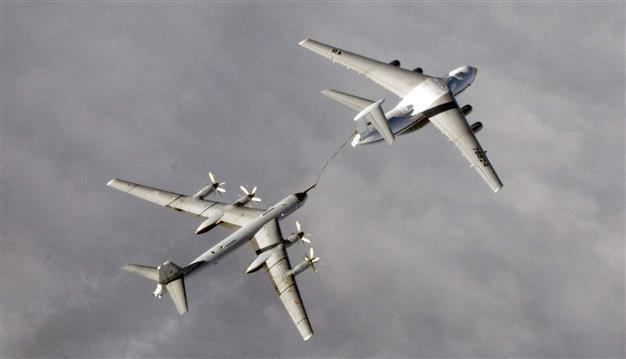Turkish fighters intercept Russian jets in Black Sea amid ‘unusual’ air activity
BRUSSELS

An undated handout photo provided by the Norwegian Army shows a Russian Tupolev Tu-95 strategic bomber refueling over an unknown location during a military exercise. REUTERS Photo
Turkish warplanes have confronted Russian jets over the Black Sea, as NATO aircraft also tracked Russian strategic bombers over the Atlantic and sorties of fighters over the Baltic, in what the Western alliance called an unusual burst of activity at a tense time in East-West relations.In all, NATO said in a statement, its jets had intercepted four groups of Russian aircraft in about 24 hours since Oct. 28, and some were still on maneuvers late on Oct. 29 afternoon.
“These sizeable Russian flights represent an unusual level of air activity over European airspace,” the alliance said.
Two Russian Tu-95s accompanied by two fighter jets were being tracked by Turkish aircraft over the Black Sea in the afternoon of Oct. 29, while flights of seven Russian warplanes were monitored on Oct. 28 and 29 over the Baltic Sea.
Seven Russian planes flew over the Gulf of Finland and Baltic Sea where they were intercepted by German Typhoon fighters, deployed as part of NATO’s support efforts for its eastern allies.
On Oct. 28, German and Danish planes were involved in tracking them as well as aircraft from non-NATO states Sweden and Finland. On Oct. 29, Portuguese F-16s posted in the Baltic intercepted a similar group of fighters and fighter-bombers.
Biggest exercise in Baltic
In a breakdown of the incidents, NATO said that in the early hours of Oct. 29, eight Russian aircraft – four TU-95 strategic bombers, capable of carrying nuclear weapons, and four tankers – were detected over the North Sea, flying in international airspace.
Four Norwegian F-16 fighters were sent up to intercept them.
Six of the aircraft then turned back towards Russia while two TU-95s continued over the North Sea, with British Typhoon fighters called in.
The two planes then flew down into the Atlantic, where Portuguese F-16s picked them up.
The two bombers subsequently turned around, flying west of Britain, apparently heading back to Russia, it said.
No airspace violation
A Norwegian military spokesman said: “We see Russian aircraft near our airspace on a regular basis but what was unusual is that it was a large number of aircraft and pushed further south than we normally see.”
A spokesman stressed there had been no violation of NATO airspace – as there was last week when a Russian spy plane briefly crossed Estonia’s border. But such high numbers of sorties in one day were, he said, rare in recent years.
NATO said it had conducted more than 100 such intercepts of Russian aircraft this year so far, about three times as many as in 2013, before the confrontation with Moscow over separatist revolts in ex-Soviet Ukraine soured relations.
President Vladimir Putin has committed to reinvigorating Russia’s armed forces, which had been undermined by the economic troubles that followed the collapse of the Soviet Union. Tension over Ukraine has seen the U.S.-led NATO alliance step up its vigilance, especially on its eastern frontiers with Russia.
The spokesman said there was no particular reason for concern over Russian warplanes exercising their right to fly in international airspace but that such sorties were shadowed by NATO aircraft as a precaution and to protect civil air traffic.
















